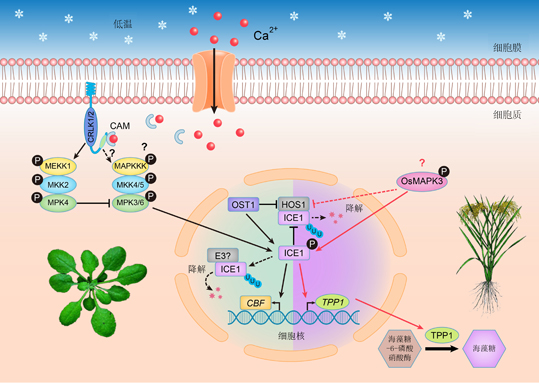

Making Sense of Cold Signaling: ICE is Cold or not Cold?
Received date: 2018-02-03
Accepted date: 2018-03-08
Online published: 2018-08-10
Cold (chilling or freezing) stress affects the growth and geographical distribution of plants, and it is one of the main factors that restricts crop yield and quality. Plants respond to cold signals by activating a series of effectors to adapt to cold stress. MAP protein kinase family plays a crucial role in plant response to environmental stresses, but it remains unclear whether they are directly involved in perception, transduction or/and networks in cold signaling. Recently, three research groups in China highlight the important role of MAP kinase in cold signaling transduction in Arabidopsis thaliana and rice, respectively. Low temperature activates MPK kinase that phosphorylates the ICE1 protein. Stability of ICE1 is controlled by MAP kinase mediated ICE phosphorylation, thus regulating freezing and chilling tolerance in plants. Their studies have advanced our understanding of the ICE1-mediated network of plant cold responses, which is an important breakthrough in the field. The outcome of these studies would provide a powerful theoretical basis for future molecular design breeding in crops.

Key words: cold response; phosphorylation; MAPK cascades; ICE1; OsTPP1
Duan Zhikun , Qin Xiaohui , Zhu Xiaohong , Song Chunpeng . Making Sense of Cold Signaling: ICE is Cold or not Cold?[J]. Chinese Bulletin of Botany, 2018 , 53(2) : 149 -153 . DOI: 10.11983/CBB18039
| [1] | 刘静妍, 施怡婷, 杨淑华 (2017). CBF: 平衡植物低温应答与生长发育的关键. 植物学报 52, 689-698. |
| [2] | Chinnusamy V, Ohta M, Kanrar S, Lee BH, Hong X, Agarwal M, Zhu JK (2003). ICE1: a regulator of cold- induced transcriptome and freezing tolerance in Arabidopsis.Genes Dev 17, 1043-1054. |
| [3] | Ding YL, Li H, Zhang XY, Xie Q, Gong ZZ, Yang SH (2015). OST1 kinase modulates freezing tolerance by enhancing ICE1 stability in Arabidopsis.Dev Cell 32, 278-289. |
| [4] | Dong CH, Agarwal M, Zhang Y, Xie Q, Zhu JK (2006). The negative regulator of plant cold responses, HOS1, is a RING E3 ligase that mediates the ubiquitination and degradation of ICE1.Proc Natl Acad Sci USA 103, 8281-8286. |
| [5] | Furuya T, Matsuoka D, Nanmori T (2013). Phosphorylation of Arabidopsis thaliana MEKK1 via Ca2+ signaling as a part of the cold stress response. J Plant Res 126, 833-840. |
| [6] | Jia YX, Ding YL, Shi YT, Zhang XY, Gong ZZ, Yang SH (2016). The cbfs triple mutants reveal the essential functions of CBFs in cold acclimation and allow the definition of CBF regulons in Arabidopsis. New Phytol 212, 345-353. |
| [7] | Kim SH, Oikawa T, Kyozuka J, Wong HL, Umemura K, Kishi-Kaboshi M, Takahashi A, Kawano Y, Kawasaki T, Shimamoto K (2012). The bHLH Rac Immunity1 (RAI1) is activated by OsRac1 via OsMAPK3 and OsMAPK6 in rice immunity.Plant Cell Physiol 53, 740-754. |
| [8] | Li B, Jiang S, Yu X, Cheng C, Chen SX, Cheng YB, Yuan JS, Jiang DH, He P, Shan LB (2015). Phosphorylation of trihelix transcriptional repressor ASR3 by MAP KINASE4 negatively regulates Arabidopsis immunity.Plant Cell 27, 839-856. |
| [9] | Li H, Ding YL, Shi YT, Zhang XY, Zhang SQ, Gong ZZ, Yang SH (2017). MPK3- and MPK6-mediated ICE1 phosphorylation negatively regulates ICE1 stability and freezing tolerance in Arabidopsis.Dev Cell 43, 630-642. |
| [10] | Li HW, Zang BS, Deng XW, Wang XP (2011). Overexpression of the trehalose-6-phosphate synthase gene OsTPS1 enhances abiotic stress tolerance in rice. Planta 234, 1007-1018. |
| [11] | Lourenco T, Sapeta H, Figueiredo DD, Rodrigues M, Cordeiro A, Abreu IA, Saibo NJ, Oliveira MM (2013). Isolation and characterization of rice (Oryza sativa L.) E3-ubiquitin ligase OsHOS1 gene in the modulation of cold stress response. Plant Mol Biol 83, 351-363. |
| [12] | Ma Y, Dai XY, Xu YY, Luo W, Zheng XM, Zeng DL, Pan YJ, Lin XL, Liu HX, Zhang DJ, Xiao J, Guo XY, Xu SJ, Niu YD, Jin JB, Zhang H, Xu X, Li LG, Wang W, Qian Q, Ge S, Chong K (2015). COLD1 confers chilling tolerance in rice. Cell 160, 1209-1221. |
| [13] | Miura K, Jin JB, Lee J, Yoo CY, Stirm V, Miura T, Ashworth EN, Bressan RA, Yun DJ, Hasegawa PM (2007). SIZ1-mediated sumoylation of ICE1 controls CBF3/ DREB1A expression and freezing tolerance in Arabidopsis.Plant Cell 19, 1403-1414. |
| [14] | Nuccio ML, Wu J, Mowers R, Zhou HP, Meghji M, Primavesi LF, Paul MJ, Chen X, Gao Y, Haque E, Basu SS, Lagrimini ML (2015). Expression of trehalose-6- phosphate phosphatase in maize ears improves yield in well-watered and drought conditions.Nat Biotechnol 33, 862-869. |
| [15] | Teige M, Scheikl E, Eulgem T, Dóczi R, Ichimura K, Shinozaki K, Dangl JL, Hirt H (2004). The MKK2 pathway mediates cold and salt stress signaling in Arabidopsis.Mol Cell 15, 141-152. |
| [16] | Wingler A (2002). The function of trehalose biosynthesis in plants. Phytochemistry 60, 437-440. |
| [17] | Yang T, Chaudhuri S, Yang L, Du L, Poovaiah BW (2010). A calcium/calmodulin-regulated member of the receptor- like kinase family confers cold tolerance in plants.J Biol Chem 285, 7119-7126. |
| [18] | Zhang ZY, Li JH, Li F, Liu HH, Yang WS, Chong K, Xu YY (2017). OsMAPK3 phosphorylates OsbHLH002/OsICE1 and inhibits its ubiquitination to activate OsTPP1 and en- hances rice chilling tolerance.Dev Cell 43, 731-743. |
| [19] | Zhao C, Wang P, Si T, Hsu CC, Wang L, Zayed O, Yu Z, Zhu Y, Dong J, Tao WA, Zhu JK (2017). MAP kinase cascades regulate the cold response by modulating ICE1 protein stability.Dev Cell 43, 618-629. |
| [20] | Zhao CZ, Zhang ZJ, Xie SJ, Si T, Li YY, Zhu JK (2016). Mutational evidence for the critical role of CBF transcription factors in cold acclimation in Arabidopsis.Plant Phy- siol 171, 2744-2759. |
/
| 〈 |
|
〉 |